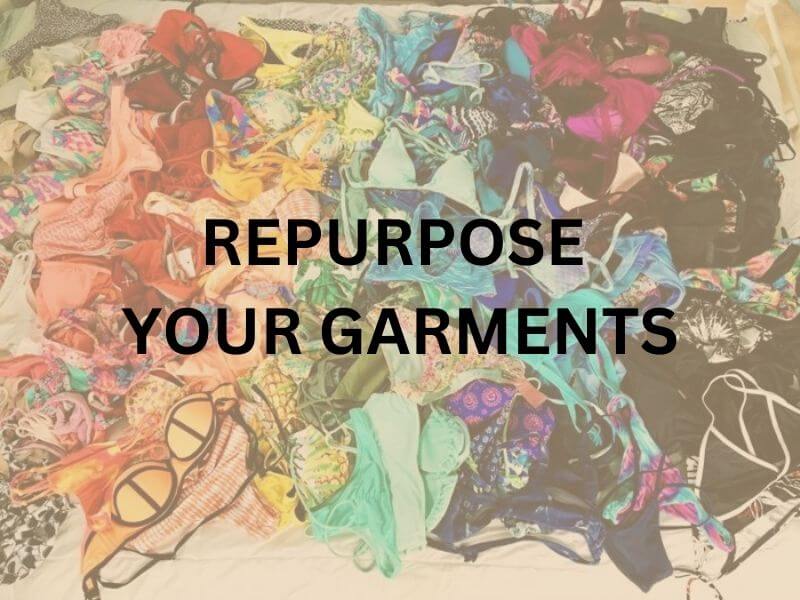Swimsuits are a staple for most people during summer, but a common issue that many face is sagging. When wet, swimsuits can lose their shape and stretch, causing them to sag and become unflattering. In this blog, we’ll explore why swimsuits sag and what you can do to prevent it.
All garments, of any type, will eventually 'retire'. Either they will lose their shape, their colors will fade, fall out of fashion or the item just doesn't fit you the way it once did.
Some garments, like swimsuits and athletic apparel may also start sagging. When wet or even when dry, swimsuits of lower quality will lose their elasticity and start 'hanging' or bulge.
The main reasons why swimsuits sag
-
Fabric quality: The quality of the fabric used to make the swimsuit plays a significant role in determining its durability and resistance to sagging. Cheaper swimsuits are often made with low-quality, thin materials that stretch easily and fail to retain their shape. On the other hand, high-quality swimsuits are made from sturdier fabrics that are more resistant to sagging.
-
Improper fit: A swimsuit that is too big for you is more likely to sag. When the swimsuit is not tight enough, it can lose its shape and stretch, causing it to sag. To avoid this, make sure you choose a swimsuit that fits you properly and is snug without being too tight.
-
Wear and tear: Swimsuits are designed for use in water, but over time, exposure to chlorine, saltwater, and UV rays can weaken the fabric and cause it to sag. To extend the life of your swimsuit, rinse it thoroughly after each use and avoid exposing it to harsh chemicals or prolonged sun exposure.
-
Age: Swimsuits, like all clothing, can become stretched out and lose their shape over time. The older the swimsuit, the more likely it is to sag. To keep your swimsuit looking its best, follow proper care instructions and replace it every few years.
What Sauipe is made of
At Sauipe, our goal is to provide you with swimwear that lasts. When it comes to quality, we believe the higher the better. Not only do we want to make your investment worth it, but we also aim to reduce the amount of discarded swimwear each year in landfills.
Sauipe swimsuits are made using high-quality fabrics with composition of 87% polyamide and 13% spandex.
The fibers used in swimsuit manufacturing
We will now discuss the fibers and fabrics used in our swimwear products, and how that high quality will prevent your swimsuit from sagging.
Sauipe uses fabrics that combine polyamide and elastane. Both are man made materials. Staying true to our values, we will also discuss how Sauipe finds a balance when using these man made materials in order to lessen our impact on the environment.
Elastane
A good garment should not only look well-made and be of high quality, but it should also fit comfortably.
Some materials used in clothes, such as polyester, nylon, cotton, wool, etc., do a very good job at delivering great products, and are comfortable to the touch and to wear. But they don't quite provide the perfect fit.
That comfortable, elastic, perfect fit is provided by Elastane.
Elastane, also known as spandex, is a synthetic fiber that is known for its exceptional elasticity and versatility. It was invented in 1958 by a chemist named Joseph Shivers at the DuPont laboratory in Wilmington, Delaware, USA. The goal of the research was to create a new type of fiber that could stretch and return to its original shape, making it ideal for use in clothing and other textile products.
Before the invention of elastane, natural fibers like rubber and latex were used to create stretchy clothing and other products. However, these materials were often heavy, uncomfortable, and difficult to care for. With the development of elastane, a new type of stretchy fiber was born that was lightweight, comfortable, and easy to care for.
Today, elastane is widely used in the clothing and textile industry, especially in the production of swimwear, activewear, lingerie, and hosiery.
Its unique properties have revolutionized the world of fashion and have made it possible to create comfortable and stylish clothing that moves with the body. Whether you're hitting the gym, the beach, or just running errands, chances are you're wearing a garment that contains elastane.
Elastane is considered an elastomer due to its ability to recoil to its original length after being stretched up to seven times its length. Its exceptional elasticity allows it to stretch and return to its original shape without losing its shape or strength, making it ideal for use in garments that require a lot of movement.
LYCRA®
Lycra® is a brand name of elastane. It was invented in the 1950s by the DuPont company and was initially marketed under the brand name Lycra.
The brand name "Lycra" has since become synonymous with elastane and is widely recognized in the clothing and textile industry.
Polyamide
Polyamide is a synthetic polymer that is commonly used in the production of textiles and clothing. It is also known as nylon and is known for its strength, durability, and flexibility.
Polyamide fibers are created by the polymerization of lactams or amino acids, resulting in a long-chain molecule that can be spun into fibers. These fibers are then woven into fabric, which can be used to make a wide range of clothing and textile products.
Polyamide is widely used in the production of activewear, swimwear, and lingerie, due to its strength, durability, and ability to wick moisture away from the skin and dry quickly.
Polyamides occur both naturally and artificially.
Natural polyamides refer to polyamides that are derived from naturally occurring materials, such as proteins. Examples of naturally occurring polyamides are wool, silk, and keratin (yes, the protein found in hair, nails, and feathers).
Transforming the Fibers Into Fabric
There are many different swimsuit fabrics, that differ in the quality of the fiber, the composition and how the fibers are woven to produce the final product.
Not all polyamides and elastane are created equal. Depending on their chemical composition and how they are spun, these fibers can have more or less elasticity, hold on to colors better, be more resistant to the elements, etc.
These fibers are woven into fabrics, and the weaving methods can also differ from fabric to fabric and even more so from vendor to vendor. For instance, two materials that have the same 87% polyamide and 13% elastane composition can look and feel different to the touch, and they can also perform differently when you wear the garment. That is, in part, due to the weaving and manufacturing methods.
The fabrics we use at Sauipe are extremely durable, resistant and elastic. If you stretch the fabric of your swimsuit you will see that it stretches both ways and the weaving is tight, so you can barely see any 'lines' when they stretch. These are characteristics of a very durable and high quality fabric.
How Harmful Are These Fabrics?
They are not harmful to your skin, but they do leave some footprint on the environment.
The fabrics used in Sauipe's swimsuits are manufactured with auditable materials and processes. Our vendors meet high standards of sustainability in the textile industry, such as: compostability; biodegradability at disposal; water recycling and proper treatment of any used chemical; no genetic modifications; closed production cycles; only use of non-toxic and non-harmful products to human health and production traceability.
They also have Oeko-Tex® Class I and II certification , an external and international audit that attests to the absence of toxic products in the fabrics used as garments, confirming that they are safe for human skin.
The yarn used in the manufacturing of our fabrics is the first biodegradable polyamide in the world developed in Brazil by Rhodia®.
The decomposition that used to take decades to occur for conventional polyamide, occurs much faster now: 50% of the decomposition happens in the first year and in 3 years the fabric is completely decomposed - when discarded in an anaerobic environment/landfill. The remaining decomposition occurs in an even shorter period.


Making the Cut
One key aspect of preventing swimsuits from sagging is the cut of the suit. Even small differences in millimeters or 1/8 of an inch can impact the appearance and fit of the suit. The way the fabric is cut and the direction it is cut in, as well as whether the fabric has been properly "rested" before cutting, can all play a role in the final outcome.
It's worth noting that each brand has its own unique cut and fit, and the same goes for women's bodies. We are all different and two swimsuits made from the same material can fit differently based on how they are cut. Careful production is crucial to ensure that the swimsuit stays true to size and fits your body perfectly.
Caring for your Swimsuit
Proper care is a very important factor that impacts the way your suit will fit and how long it will last. Proper care will also prevent the suit from sagging.
We discuss proper swimwear care in another blog post (How to Wash Swimsuits And Other Tips), but here is the gist:
- pretreat your swimsuit with white vinegar and water (details on that blog post)
- be careful where you sit: rough surfaces will damage your suit
- always rinse after each use
- use mild, color safe detergent, and you don't need too much of it
- let the suit dry flat
- never, never, never keep a swimsuit wet inside a bag or rolled in a towel
- no washer or dryers
- lay your suit on a flat soft surface to dry. A clean towel is a great surface.
A Final Note: Sustainability
Our commitment to the environment is at the heart of who we are. We understand that every manufacturing process has an impact on the environment, but we are dedicated to taking all necessary steps to minimize our footprint. With global warming, depleted resources, and increasingly frequent floods and fires affecting communities all over the world, it's more important than ever to take action to contain their growth.
Although this blog post is about 'Why Do Swimsuits Sag?', this topic meets sustainability when it comes to quality. A higher quality swimsuit not only will not sag, but it will also last much longer. And that translates into a more sustainable product.
One may wonder, if the fabric Sauipe uses has man made fibers, why shouldn't I just buy a 100% cotton swimsuit? You may. But as discussed above, natural fibers like cotton do not offer elasticity, which is important for a great fitting swimsuit.
Other important factor to consider is how your garment is manufactured. All manufacturing processes have some impact on the environment. Even those that produce 100% cotton garments. But following high standards of sustainable production, lessening the release of chemicals in the environment, recycling, reusing and economizing on resources are the foundation for a sustainable production. We cannot stop manufacturing, but we can make it better and more responsible.
Finding the right balance between use of resources, production and extending the life of any product is key to lessen the impact on the environment.
To learn more about Sauipe's commitment to a sustainable product, please read our Brand Ethics page.
We Will Not Sag!
The bottom line is, our suits will not sag because of the high quality materials we use, the way we cut our swimsuits, and because we know you will give your swimsuit all the TLC it deserves.
The best swimsuit you will ever wear is waiting for you! Here is our complete collection.
If you have any question or comments, please email us at info@sauipeswim. We would love to hear from you!






Leave a comment (all fields required)